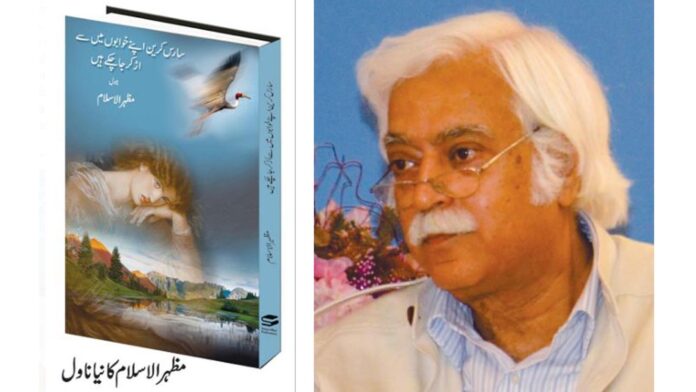Staff Reporter
The readers of the novel “Saras Crane Apne Khawabon Mein Se Ur Kar Ja Chuke Hain” by eminent fiction writer of Pakistan Mazharul Islam embark on an astonishing storytelling journey where they feel as though they were in a time machine, soaring like a bird through the layers of centuries gone by.
This was said by Ashfaq Azar, the well-known writer and journalist, while discussing Mazharul Islam’s latest novel to a gathering of book lovers here on Monday.
Mazharul Islam, he said has penned down an innovative novel, rejecting the conventional frameworks of fiction writing and one feels convinced to agree with him because never before such an experiment in fiction was performed, he said.
When Mazharul Islam wrote “Muhabbat Murda Phoolon Ki Symphony,” he upheld principles of aesthetics thought and art. That was written to breathe fresh life into the sentiments of love and to make us perceive love in a new light. ‘Saras Crane’ is also a work of nostalgia, exploring what the modern age has inherited from bygone eras. Ashfaq Azar said in his latest novel, Mazhar blends reality, fantasy, time travel, and surrealism, creating an enchanting tapestry of mysticism. As a result, this novel weaves a spellbinding magical realism into its very fabric.
The story emphasizes that every person has a bird within him. This tale of love centers around a Saras Crane. The Saras Crane embarks on a backward journey i.e. from the 21st century to the 18th, where countless Saras Cranes from his tribe eagerly await his return in a place called “Ashiana-e-Wafa.”
Why did Mazharul Islam choose the Saras Crane as the focal point of his novel? Ashfaq Azar himself answers this question: For this iit’s crucial to learn more about Saras Crane.
Saras cranes are perceived as a symbol of fidelity and good fortune in ancient tales. They are believed to bring happiness, long life, and a promise of paradise. Sailors from Sindh used to install sculptures of Saras cranes in their boats, hoping that they would be able to soar like birds on open waters. In the same fashion, there is a bird Saras Crane in Mazhar’s heart.
This is not for the first time that Sarus Crane has been mentioned in his novels. In “Muhabbat Murda Phoolon Ki Symphony” we also find them.
Mazharul Islam takes a captivating journey through ages—from the 21st century to the 18th—in the guise of a Saras crane. Azar said in his fascinating voyage, the protagonist (Saras or Mazhar himself) encounters the 18th century, which he describes as a market of charlatans, fraudsters, power-hungry individuals, promise-breakers, injustices, and deceit. He dubs it the “dictionary of deceivers.”
Mazharul Islam paints 19th century as a simple, comforting, and love-filled era. Mothers used to tell the children to stay away from lies by saying, “The child who tells a lie grows horns on his head.” Therefore, whenever the children of the 19th century engaged in the small trickeries of falsehood, their hands would involuntarily move towards their heads to check if horns were really sprouting.
This unique journey through time and space provides a lens into the different layers of human experience, revealing the absurdities and peculiarities of each era, culture, and society and thus makes the novel a must-read concluded Ashfaq Azar.
Overall, in this novel, Mazhar-ul-Islam emerges as a writer who not only presents the elements of romance, realism, surrealism, and symbolism in his writings but also shares his emotions and inner feelings with his readers. This novel is not only gaining popularity in literary circles but also sparking new discussions and exploration of new horizons, he said.

















